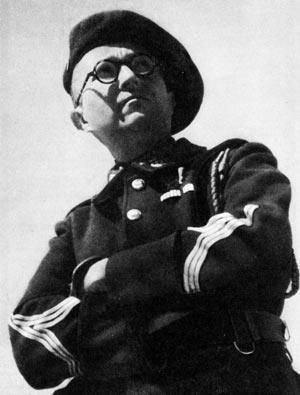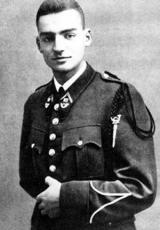Maurice Anjot

aka "Bayart"
Born in Rennes on 21 July 1904, Maurice Anjot grew up in a family that held very strong religious and national traditions. That is where he received his sense of duty and the moral qualities that, at a very early age, gave him a maturity and an intelligence that his superiors always admired. He was a robust, lively man. At first contact he seemed cold and reserved, but it quickly became clear that while he did not communicate freely and did not seek to stand out, it was because he lived things intensely within himself with his responsibilities, his ideals and his faith.
He had a brilliant military career. He graduated from Saint-Cyr in 1925 and returned in 1929 as an instructor for six years. His superiors always saw "a rare set of moral, intellectual and physical qualities" in him, making him a well-rounded individual. He gave the impression of an "energetic and thoughtful leader", demonstrating "very sound judgement, common sense, a steady eye and tact". Named captain in 1935, he earned a well-deserved military citation during the fighting on the Aisne and on the Marne. He was assigned to the 27th BCA in Annecy after the Armistice.
He was an elite officer who decided to join the French Résistance in the spring of 1941. Police reports for “anti-governmental activities” give us an idea of the kinds of activities he was involved in during that year. He had multiple contacts with reserve officers to set up secret battalions in the region. “In the spring of 1941,” said a witness questioned during the investigation carried out in the autumn of 1942, “I received a visit from Captain Danjot or Anjot, Master Warrant Officer in the 27th Chasseurs Alpins. He was wearing civilian clothes and had come by car. He introduced himself and gave an overview of the situation in France. After the defeat in 1918, the Germans had set up a secret organisation to develop an army. It was normal for France to do the same, he said... This is how the movement was organised – a battalion similar to the “Chasseur” battalions was to be set up in each arrondissement, with reserves, including about a thousand men to be mobilised by individual convocation.”
His resistance plan could have been particularly effective. At the right time, a veritable reserve army could have come out of nowhere from behind the lines, suddenly expanding the armistice army. The project was all the more daring in that it dated from the beginning of 1941, at a time when most French people were not even thinking about a domestic resistance. The invasion of the “free zone” in November of 1942 put an end to it. Other methods had to be found, but the goal was the same – to reconstitute battalions “for the day when, as Anjot said according to another police report, we’ll have to clean up the country.” The Armée Secrète” was born. Captain Anjot was one of its main agents in the Haute-Savoie department, under the orders of Colonel Vallette d'Osia.
After his superior was arrested, he also led the life of a fugitive. He grew a moustache and sideburns; he became a different man with a different identity. He found a place to stay with friends, then with a priest, then at a farm. He was the same man in the Résistance that he was in the army – a methodical man who obstinately worked to pursue his ideals. He made important contacts himself; he centralised information; he maintained contacts with accomplices and organised underground activities – he alone knew their scope and their utility. At Glières, he did not hesitate to go to the intendant of police, Colonel Lelong, to negotiate. "My life is of little importance,” he said to those who wanted to stop him from taking the risks of such an approach, “if I can save the lives of others.” A few days later, Tom was killed in the fighting at Entremont. An officer was needed to continue his work at all costs, so that Glières would always be Glières. Anjot stepped forward and it seems that the officers on the Plateau were ardently awaiting his arrival.
He wrote a letter to his wife that shows what kind of man he was. "You know how events have turned since you left. Our comrade Morel’s sudden death led to a need for a replacement. If I took on this heavy load, it is because I felt that it was my duty. Don’t think that it wasn’t hard for me to take this decision, with you gone; but maybe your very absence enabled me to overcome the family aspect of the question more freely. Many people, with more or less cowardly and dishonest dispositions, currently turn away from their national duty. As an officer, I cannot do that. I hope that you and Claude will bravely accept my decision."
Alongside this spiritual testament, he added a word for his son. "I especially suggest that you always be kind to your mother. Obey her and always be the good little student I so enjoyed working with. I’ll be home as soon as possible and we’ll return to our former life. Don’t forget your daddy in your prayers."
In fact, even as he tried to reassure his family, he understood the situation far too well to be optimistic. Instead of living in the enthusiasm of the Plateau, he personally had to closely follow events day by day; he knew the threats that were building up. He didn’t expect to come back down; he made that clear to a friend with whom he spent the last evening before he took up his new command position. Forever methodical, he drew up plans with him for concerted action in case the situation didn’t change too quickly.
He went up to Glières on 18 March. It was quite an expedition to reach the Plateau through the roadblocks. He carried with him the banner of the company he had commanded at Kehl Bridge, to fly it symbolically over Glières. He also brought his Chasseur Alpin battle dress jacket with him: "If I must die”, he said, “I want to die Anjot”. That is why his moustache and sideburns had disappeared when he arrived.
Events unfolded too quickly for him to show his full worth. During the week that the Plateau was able to hold out, he just had time to move into his new command post and to hastily reinforce the defences. The enemy now had the initiative. Anjot had the great idea to save their honour by saving as many lives as possible – he was concerned for the more than four hundred young men who had inspired him to come and take on this dire duty. After proudly refusing to negotiate with the militiamen, he did everything he could to fend off the imminent attack. In the evening of 26 March, when his defences had been irreparably breached, he ordered an evacuation, giving each leader detailed instructions for his retreat. He headed out with a large column into the Gorge d'Ablon. He had reached the village of Nâves, with Lieutenant Lambert Dancet and Vitipon, when a German roadblock opened fire on their little group and on the Spaniards following them. They fought back but soon fell. Anjot was shot down in a hail of machinegun fire. P. G.



